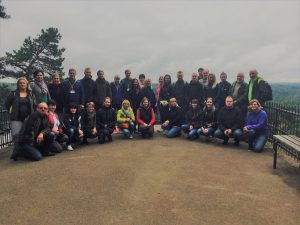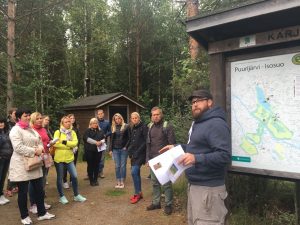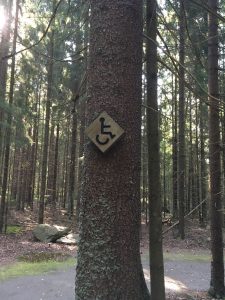
In August, 34 representatives of Kurzeme region municipalities, Kurzeme Tourism Association, Nature Conservation Agency, as well as four project partners from Lithuania (Žemaitija National Park, Biržai Regional Park, Aukštaitija National Park and Labanoras Regional Park, as well as Kretinga District Municipality) took part in the experience exchange visit in Finland. The participants visited 4 national parks (Nuuksio, Puurijärvi-Isosuo, Kurjenrahka, Teijo) and 2 nature reserves (Laajalahti and Aulanko), where they met with the Finnish colleagues and visited nature objects adjusted for people with disabilities.
During the visit to Laajalahti nature reserve the participants met with representatives of the Espo Nature Centre Villa Elfvik and the Parks & Wildlife Finland, who informed of the activities of the Nature Centre, the nature school for children and pupils that has been established at the Centre, attendance volumes and the development activities. A significant part of the Centre’s work is devoted to teaching children and pupils in the nature. Learning of pupils at nature schools established at parks and reserves is stipulated in the Finnish curriculum in order to facilitate their understanding of the nature and environment. The visit participants acknowledged that it would be worthwhile to take over the Finnish experience on the learning of children and pupils in the nature, as it is the nature itself where they can get an in depth knowledge of and acquaint themselves with environment and environmental processes. The representatives of the Nature Centre also highlighted that the Parks & Wildlife Finland has prepared a special Disability Programme that contains the basic conditions for constructing and maintaining nature trails and objects to be used by people with disabilities as well as the development strategy.
Guided by the representatives of the Reserve, the participants tracked the nearby nature trail, which, along with the lowest level of the bird watching tower, has been adjusted and available for people with disabilities. The different trail sections have been laid out of several different surface materials (a special grit, wood, plastic) in order to define the most appropriate one with the course of the time. At present the Finnish colleagues acknowledged the special grit and wood as the most appropriate materials, since the plastic surface, although potentially more resistant and durable, gets slippery during the rain and encumbers movement. There have been information signs placed along the trail with information on birds, animals and plants present at the Reserve, though the information is not yet available neither in Braille, nor in the format of audio records. At the same time, the representatives of the Reserve mentioned of their efforts to provide the information in audio format (QR codes to be scanned) in the future.
While visiting the Nuuksio National Park, the participants had a chance to visit the Finnish Nature Centre “Haltia”, which representatives provided information on the Park, the Nature Centre, nature tourism issues, as well as the accessibility to nature trails and objects within the Park and the Centre itself.
The Centre “Haltia” was built in 2013 and in 2015 was awarded the first ever sustainable development prize in the prestigious European Museum of the Year competition. The Centre amazed the participants with its’ modern shape, sustainability conception, modern expositions, which present the Finnish nature values in an attractive and catching manner. After visiting the Centre and its’ expositions, the participants tracked the nearby 2km long nature trail, which has been adjusted to people with disabilities. The group was also accompanied by a park ranger – a girl in a wheelchair. In addition, one of the participants had a chance to track the trail in a wheelchair offered by the Nature Centre, in order to discuss how suitable is the trail for people with disabilities after experiencing the wheelchair himself as well as the overall challenges and needs to improve accessibility. The examination of the trail was interfered by the storm, yet it proved that while tracking more difficult routes, people with disabilities would require an accompanying person who could help to get through some tough trail sections – it could be either an accompanying person invited by the person with disabilities himself or an assistant provided by the Park. Likewise, the participants had an opportunity to ascertain themselves that even a 1 cm slope difference may significantly affect the trail wheeling options. Also the trail surface and maintanance work (mowing, removing of leaves etc.) play an essential role. At this park, the participants also visited the visitor’s information lodge in the park territory, where in addition to information on animals and plants existing at the park, information in Braille script has also been provided, as well as an access for people with impaired mobility to viewing platform and rest and campfire places on the coast of the lake.
At the Puurijärvi-Isosuo National Park, the participants were able to acquaint themselves with the successfully established cooperation between local farmers and the Park administration in depasturing the meadows at the Park.
At the Kurjenrahka National Park, the participants visited the nature footbridge that has been specifically constructed for people with disabilities, that lead to lake Savojärvi, the accessible resting area and the exposition. Rest rooms adjusted for people with disabilities had also been installed at the start opf the footbridge. The footbridge ended up with an access to pontoon pier that had been constructed in a way to allow people with disabilities to access the lake (swim) and the boat (get in/get out, have a ride by boat). At the Teijo National Park, the participants tracked the 600m long nature trail that ended up with a well-equipped resting place by the lake, with angling opportunity, which has also been adjusted for people with disabilities, and where visitors can clean and cook the fish that they managed to catch.
Overall, the participants highligted that the visit provided a truly valuable experience, as only by experiencing the wheelchair drive themselves and discussing with people with disabilities of their needs and possibilities, it is possible to understand how to correctly form the accessibility to nature trails and objects, since even a single 1 cm trail slope difference can seriously encumber the trail tracking possibilities. At the same time, the participants acknowledged that the Finnish experience proves that it is not always necessary to devote huge resources in order to improve accessibility. One option to improve the overall nature tourism accessability is to ensure at least the minimum accessibility requirements (e.g. by providing access to disabled persons to travel with an accompanying person) and then gradually improving the accessibility options (access to more objects along the trail (e.g. the floating pontoon piers, watching towers and platforms, informtion in Braille and audio materials etc.)). This allows to reach a good result in allowing to access more nature objects (and more nature objects farther from the city centers) and thus improve the overall accessibility. Although most of the Finnish nature trails are equipped with visitor counters, yet, as pointed out by the Finnish colleagues, they count only the overall number of visitors, not dividing the number of the visitors with disabilities, that could be essential in the aspect of the planning the accessibility of specific objects in the region in question as well as the socaieconomic development measures.
The experience exchange visit has been organised with support of the Interreg Latvia-Lithuania Cooperation Programme within the framework of the project No. LLI-010 “Nature Tourism for All” (UniGreen).
The above reflects author’s views and the Managing Authority of Latvia-Lithuania Programme is not liable for any use that may be made of the information contained there in.
Information prepared by:
Alise Lūse
UniGreen Project Manager
Kurzeme Planning Region
Tel.: + 371 26567874, alise.luse@kurzemesregionslv




